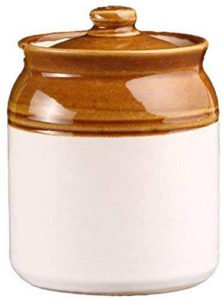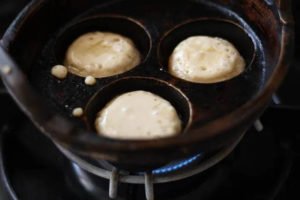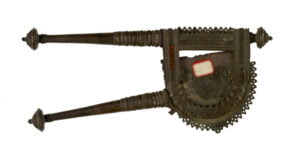18 Ancient Indian Cooking Utensils in a Traditional Kitchen
Indian food has been referred to as very tasty food. This did not come by, just like that. The food prepared, is process intensive and has a holistic approach. By holistic we mean that
- It has to be followed the way it has to be
- There are divine hands working behind in cooking such tasty food
- The food prepared is considered god-given without a second thought
This divinity and process-intensive procedures have to be followed exactly the same way, as it is brought forward from the legacy. This involves using the same materials and shapes in the utensils that are being used from time immemorial.
The taste difference can only be experienced by the tongues that have tasted the food that is prepared using the ancient Indian cooking utensils. We have listed here those that act as the catalyst in increasing the taste of the food that is cooked otherwise. You can have a look at the below video about which we will talking in the near future.
History of Utensils in India
By using utensils used in olden days, even preparing this food joins the divine forces that we have mentioned earlier. These are also worshipped in Ayudhapuja comparing themselves to god. So, they form an important aspect of understanding these divine beings to understand the food culture in India.
Before digging out on the ancient Indian cooking utensils, let us first get an idea of the raw materials that were used to manufacture these olden days’ kitchen equipment. They form the basis on which these utensils were being used. From a broader perspective, there were mainly five categories that were used from ancient times in India.
They are:
Stones
These are generally used in grinding. As opposed to the stainless steel blades that are used in the mixers, for grinding using sharp blades that are made out of stainless steel, the usage of stone goes back to olden days of the kitchen.
The taste of the ingredients, when ground using ancient Indian cooking utensils manufactured by stones cannot be compared to the others. This option along with its unique taste is healthier too.
Let us see below the advantages of stones in grinding, over the others.
- Stones do not get heated up, unlike blenders and mixers that use stainless steel, and end up in getting heated. This is not only unhealthy, in addition to that, there is also a loss in taste.
- Even when it comes to wear and tear, the stone grinders serve a long duration, due to its strength as opposed to what we see in the sharp edges of a stainless steel blade.
Please check out some traditional stone tools that can help you in your kitchen in increasing the taste of the food you prepare by following this link.
Clay
Clay is used in many olden days’ kitchen equipment. Though clay is a bad conductor of heat, it is not that it cannot pass heat through it at all. There is a slow and constant heat that gets transferred to the whole cookware making it easy to heat uniformly.
The best item that we have prepared back at our home using clay is Phulka. The clay Tawa comes in handy, though initially, it takes a lot of time to get heated as said earlier.
Similarly, it can be used for various other heating purposes like in Handi, Chulha, etc. that we will cover in the further sections.
They are also used to store food once they are cooked.
These are also advantageous over the others in many ways like:
- Clay pots add nutrients to the food like
- Calcium
- Phosphorous
- Iron
- Magnesium
- Sulfur
- They are alkaline in nature, which neutralizes the acid food that we consume. Most of what we eat is acidic in nature. So, this quality of the clay pot is extremely useful
- It gets heated slowly, and due to this, oil and moisture are all retained in the food during the time of its cooking
- Their easy availability makes it even more advantageous as it will be available locally too
- Since there exist small pores in the pots, there is moisture and heat that is circulated through the food adds to the taste and aroma, making them different, which cannot be made available in other types of utensils. Of course, as said before, this is experienced only by the people who have the sensitivities to experience them
Please check out some traditional clay and ceramic equipment that can help you in your kitchen in storing the food you prepare by following this link.
Ceramics
Ceramics, on the other hand, are in a way sophisticated clay for the fact that they are baked to solidify. There are good both for our health and for cooking. The noticeable benefits of ceramics are as follows:
- It is inert, as they do not react with any of the food ingredients forming toxins
- They can withstand a huge temperature as high as 2700 degrees Fahrenheit making them very useful for boiling
- The flavor or our taste won’t get spoiled due to the reactions, unlike the other materials
While we use it, we should be really careful about one last thing. The ceramics picked should not be the one that is contaminated by adding poisonous substances.
Wood
Wood is a material that is a very bad conductor of electricity, including static electricity. There is no reaction whatsoever on any of the food that we eat. The only con I can think of is that the wetness of materials can spoil the quality of wood in terms of its shape.
So, these types of utensils were generally used for two purposes.
Spoon
Because of its heat resistance, it is easier to serve using wooden material. Spoons are a great way of utilizing the non-conducting nature of heat.
Oil Cold Press
There is a device that has been in use for centuries to extract oils. This device has again gained momentum in recent times to extract oil using the cold press method as opposed to the heat press method. Due to the reaction free nature of oil, wood is used in the formulation of this device.
There are advantages of this over metals that we have already mentioned previously. They are:
- Wood is scratch-free. Due to this property of wood, there are no scratches in the utensil. Making them easily handleable
- As told earlier, since it does not conduct heat, it comes very handily especially when the food is hot and they have to be served
- One of their other qualities is that it is inert, it does nor react with other materials and does not cause any other kinds of unknown harm
- It is not slippery due to which they can be comfortably held in the hands
- Even when they fall from heights they normally don’t break and other such qualities make them extremely durable
- We don’t need to be extra careful with germs and bacteria, as they don’t like wood
Please check out some traditional wood equipment that can help you in your kitchen in serve and compress the food you prepare by following this link.
Metals
The utensils made using the metals are the most used materials. They are used in many forms, each one for different purposes. As is there are several metals. Due to this fact, there are vast forms of utensils that are carved out of these.
Let us first list the metals that are used in cooking in ancient India. We should be extra careful while using metals, unlike the previously mentioned materials, as all the metals are not good when it comes to cooking.
Copper
Copper is widely used for storing water other than heating, where only the portion where fire touches the metal is made using copper. This is due to it being a great conductor of electricity. It is very reactive with most food items, so it is better to confine it to store water.
The advantages being:
- Copper has very potent antibacterial properties, if bacteria come in contact with copper, they immediately get killed
- Aids weight loss by aiding body break fats and eliminate them efficiently
- Strengthens immunity system by helping us produce new cells
- Fights off free radicals, helping us look younger
- Helps regulate blood pressure
- The antioxidant properties help fight cancer
- Regulates the working of the thyroid glands
- Beats arthritis and inflamed joints
- Beats Anemia
Copper kitchen items can be found following this link.
Cast Iron
After a very long vacation, fortunately, cast iron is coming back to the Indian kitchens.
- They are very good conductors of heat because of which they serve a great purpose in transferring heat to the Dosas or Kadais very efficiently, uniformly, saving fuel
- The iron that is heated makes the food items to absorb some amount, making us compulsorily consume them, which acts as a bonus health benefit
- Being careful about rust and some reactive acidic sour items, we can make use of this for most of the dishes along with the health benefits that it provides
Cast Iron kitchen items can be found following this link.
Stainless Steel
They are universal, in the sense that without getting rust and not reactive to any kind of food ingredients, irrespective of their taste, this can be used in cooking safely, but the health benefit bonus of cast iron is not applicable here.
Stainless Steel kitchen items can be found following this link.
Bronze
Called as Kansa in most parts of the country, it is mostly used in East India for several things, such as:
- Plates to eat our food
- Tumblers to drink water
- Serving bowls to serve food
The advantages of this metal being the health benefit of purifying the food served through it or eaten using this metal plate.
Bronze kitchen items can be found following this link.
Silver
Silver, being an expensive metal now, can be rarely seen in households. But back then, silver was used in both kitchens and religious work.
The best use case of silver is in the plates. When eaten using silver plates they throw abundant health benefits, like:
- They kill microbes present in the food
- Fresh food retention and anti spoiling capabilities
- The cooling effect that in anti-inflammatory is good for some may unhealthy people
- It enables smooth digestion
Gold
When silver is hard to be kept in our routines, it is highly likely that gold can be brought into our regular schedules. But if you can afford it, there is nothing like it. It is not just a metal that looks beautiful, but a metal packed with high benefits.
The benefits are as follows:
- Increases stamina
- Eases the joint pain caused due to arthritis
- Beneficial for people with Asthma and Breathlessness
- Strengthens the nervous system
Now understanding the types of raw materials used in manufacturing the utensils for the kitchen, let us learn about some of the commonly used utensils in the ancient Indian Kitchens.
Ceramic Jars

I remember the olden days when we had these jars used to store pickles and the likes. They are called Pingani/Peengan Jaadis where Pingani or Peengan stands for porcelain for the obvious reason that they are made up of porcelain.
Their two-colored design brings in us the nostalgic memories that we had with them. They will be white and brown in color combination and come in different sizes that cater to large joint families, which can store pickles for years together.
They are also used to store curds and ghee in small quantities for daily uses.
Spice Box
These are generally made out of wood as the spices are dry in nature it can store them without allowing heat and moisture inside, as we have studied that they are bad conductors of heat and electricity. They are called in many places as Masala Dabba, yes you guessed it right, spices are called as masala in most of the Indian languages.

The beauty of this is the compartments. There is a separate compartment for each masala or spice and a single lid that makes sure that the spices retain their spicy nature. There are many regular spices that are used like:
- Cloves
- Black peppercorns
- Cinnamon stick
- Mace and nutmeg
- Dried red chilies
- Green cardamom and black cardamom
- Mustard seeds
- Cumin seeds
- Turmeric powder
- Red chili powder
- Coriander-cumin powder
They are used on a regular basis for daily cooking. So, they are kept handy so that we can reach them whenever necessary.
Water Claypot

As the name itself suggests that they are made out of clay, they are pots, to store water. They come in different sizes and shapes. The first thing that we notice is that there are mainly two versions of this:
1. Without tap
These olden days kitchen equipment are the ones in which there are no taps to transfer water to a different container. In such cases, spoons with deep enough space to transfer water faster.
2. With tap
Here, in the bottom of the pot, there will be a hole to which will be attached, a tap. In these types of pots, it is easy to fill the water by just turning on the tap.
Narrow neck Bottle
These are made out of metals, mostly bronze. They have a small neck, a bottleneck that makes us hold them in an easier way. Some of them might even have a holder coming attached to it making them easier to hold.
Though these are containers, they were used like bottles of nowadays to drink water from them directly. If the metal used is silver, it can be used to store wine, and drink directly from them.
They were generally used to carry from one place to another during traveling. There will be no harm whatsoever caused to the water stored in them as opposed to storing the same way in plastic, which releases harmful chemicals.
Mortar and Pestle

This grinds everything that comes in between the two stones. Till now we have discussed the items that were just stored food. Let us now discuss some action-oriented utensils. These belong to such activities that cannot be compared to the modern mixer grinders.
There are two parts:
- A grinding stone that will be of a drop shape.
- The strong open container where things that can be ground are added.
To grind, the grinding stone is rotated on the open container containing materials to be ground. The more the grinding stone is rotated the better the materials will be ground.
Grain Grinder
This is a bigger version of the previous one that will be bigger and stronger than its previous counterpart. Working is the same. The base will be hollower where even the grains in a large quantity can be poured in. With some water added to the grinder, the grinding stone can be rotated till we get the right paste.
The main difference between this and the previous one is that the previous one is portable while this is not. This is normally installed in one place and will not be moved.
Bamboo Basket

These are those types of containers that are made of wood in the form of a basket. They are different pieces tied together forming a basket.
Only dry items, solid items and items like flowers can be used with these kinds of baskets. I still remember going to our neighbor’s place where I used to pick up flowers from them using these kinds of wooden baskets.
Clay Stove
Being an extension of a container, this aids us in heat or cook something in it by means of a hole where a burner of the type of wood can be placed and the items kept on the stove can be boiled.
These are the traditional stoves that were made from the sole purpose of boiling grains and vegetables. To ignite the fire, dry wood was used and this was a major contribution to the kitchen as the food humans started preparing became tastier and better.
Stone Pot

This is the same as any pot. You can refer to our clay pot and the only difference between them is the materials used to arrive at them. However, the stone pot is obviously sturdier than the clay pot.
Quality Wise, we have to be a little careful about the clay pot, in regards to the type of clay used. As long as there are no poisonous chemicals in the clay, it is a safe bet to use a clay pot.
However, this does not apply to stone pots as they are non-reactive by default.
Colander

This is a type of perforated bowl that is used to strain out water from the washed vegetables or oil from fried items. It allows liquid to strain out while it retains the solid particles on it. This is generally made out of metals like bronze, iron, ceramic. stainless steel, etc.
Murukku Press

We were waiting for Krishnashtami in our childhood days, as there were these fried items called Murukku, Chakli, Mucchore, Tengol, etc. that were pressed from this Murukku Press were prepared for Lord Krishna.
These presses function similar to the cycle pumps, where there are two parts, one concave and the other convex, with a small gap in between them. The batter is added to the concave place. The convex side of it is pressed over.
A small stenciled hole from which the batter comes out forming the shape of a Murukku or Chakli is how it works. This shaped batter is then fried, forming the food item.
This is made of metals.
Paddu Mold

Paddu is an item that has the raw materials of Dosa but looks like Idli. It has some onions added to taste. Paddus are smaller in size than Idlis, that’s because a different mold is used to prepare this.
Cast iron is the best material to be used for such purposes. They are heavily built and served the purpose of sharing the heat uniformly.
Steamer
A Steamer is a utensil used to cook food by the steaming method. They obstruct the steam from going out by helping the food get cooked faster. This method cooks food by means of water getting boiled.
They are made using metals. To withstand the steam and not letting it go outside, metal will be the best material to do that.
Coconut Scraper
This is for sure in most of the households where coconut trees are grown. This has a wooden plank attached to which on one side is a sharp knife-like object at the very edge of which is a star-shaped blade.
To grate coconut, the person has to sit on the wooden plank and push the white part of the coconut against the star-shaped blade. This will grate the coconut making the wet coconut powder fall to the bottom of the star-shaped blade.
Metal is the only material that can be used for this purpose.
Nut Cracker

A nutcracker is a cutting plier kind of an instrument that is sharp on either side. To cut the nut, they have to be placed in between the two sharp edges. They are torn in half. This comes with a metal, usually brass. As they have to be both hard and sharp, the only savior for the ancient Indians were metal-based Nut Crackers.
Churner

To churn curds to lassi, this type of utensil is used and it comes with wood as its material. This will be a stick to which pentagon-shaped blades are on one end just a stick on the other end.
While the user has to churn by alternating the rotation like oscillation after adding the required amount of water, it turns into a less viscous liquid.
Occasionally, metals are also used to make a churner, but generally, it is wood.
Noodle maker Press
These are pressed in a big thread that results in the production of noodles, also called Semiya or Shavige in Indian languages.
The Noodle maker press is a strong simple machine that is made out of metals like Iron or Bronze. They are extremely sturdy and I still remember when I used to be super happy to turn the thread of the machine that resulted in the noodles.
They looked as in the below video.
Wide-mouthed Vessel

Unlike the narrow bottlenecks, this is a vessel with a wide mouth. This is used to store anything that needs easy access and gets hard overtime or on a particular season.
They are also called as Lagan and are used even to serve people like Rice Items, etc.
So, the next time someone tells you the Indian food is yummy, now you know the utensils and simple machines that are at work behind the taste.

2 Comments
Comments are closed.